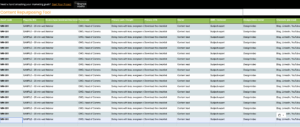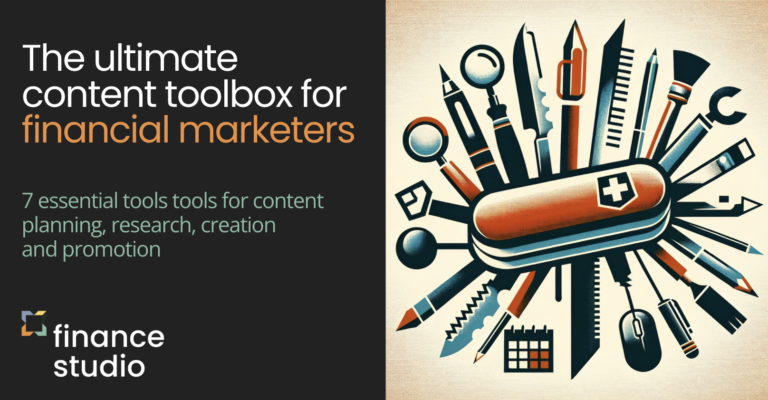Financial brands are usually shorter on coreography than on content. Marketing assets shuffle out one by one, then vanish from the feeds.
The fix isn’t “make more” but “make them work harder” … Crown a headliner and spin ten channel-native remixes from it. Tag the moments that matter, script the hooks, and set review lanes so compliance says yes on the first pass. Measure by idea, cut the laggards, and let winners compound like interest.
If you’re looking to turn one smart idea into a month of results, start with the list below. And make sure to download the free Content Remix Planner spreadsheet (below) to map drafts, compliance, legal, and publish dates in one place.
Remix your best work into results
Start with video, then waterfall. Record a flagship conversation or demo. From that single file, create shorts, audiograms, a blog recap, pull-quote graphics, an email teaser, and a slide snippet for sales.
Turn proof into a portfolio. One customer story can become a 60-second social clip, an emailed “what changed” case note, a stat card, three sales enablement slides, and a two-paragraph testimonial on relevant product pages.
Make a hooks bank. Take one long piece and write five different openings that fit each channel. Lead with a stat for LinkedIn, a question for reels, a payoff for email, a “myth vs fact” for the blog, and a two-line cold open for podcast.
Atomize research by role. Split one report into role-specific briefs. Give finance leaders a margin-impact angle, product teams a roadmap angle, and comms an audience-insights angle.
Carousel the best bits. Lift the five most shared lines from a webinar and drop them into a square carousel. Add a CTA in the final frame that points back to the full resource.
Build a “from the archive” calendar. Every Friday, resurface one evergreen post that still answers a real question. Update two lines, refresh the image, and re-publish with a timestamped editor’s note.
Create compare-and-contrast sets. Recut an explainer into side-by-side cards: option A vs option B, old way vs new way, risk vs reward. These outperform on social and in nurture.
Localize the winners. Take your top three evergreen posts and create region-specific versions. Update screenshots, examples, and compliance notes for each market.
Turn internal gold outward. Convert training decks or leadership town-hall slides into thought-leadership posts, FAQ pages, or a short public webinar.
Chop transcripts into threads. Push interviews or webinars through AI transcription. Edit into three snackable LinkedIn threads and a Q&A blog with jump links.
Data to visuals. Move high-performing stats into charts, one-number tiles, or simple GIFs. Visuals travel further than paragraphs.
Build a quote library. From every long-form asset, save six pull quotes tagged by topic. Use them to seed PR outreach, nurture emails, and social captions.
Create the “what to do now” spin. Strip one long article down to the final three actions. Package those as a one-page checklist or printable PDF.
Turn objections into content. Ask sales for the five most common objections. Answer each in a short post, a 30-second clip, and a one-slide proof point.
Republish in a new format. A webinar becomes a mini-course with three lessons. An e-book becomes a five-email series. A podcast becomes a searchable show notes hub.
Build role-play reels. Take a case study and reenact the key moment as a 45-second role-play video. Humor works. So do simple screen-recorded “what I’d click next” walkthroughs.
Syndicate the summary. Offer partners and associations a 300-word summary of your flagship asset with a link back to the full piece. Provide them a square image and a prewritten caption.
Make calculators from paragraphs. If a post explains “how to estimate,” turn that logic into a simple Google Sheet or web calculator. Promote both.
Spin “before and after” diagnostics. From a how-to guide, build a 10-question self-assessment. Return a score plus links to the three most relevant deep dives.
Capture community with an Ask Me Anything. Host a 20-minute audience AMA. Publish the top five questions as a blog, cut three shorts, and add the answers to your product FAQ.
Create a “five slides only” deck. Convert the essence of a report into five slides for speakers and sales. One storyline, one chart, one proof, one case, one CTA.
Playlist your backlog. Group related videos or posts into playlists or reading lists for each persona and funnel stage. One link equals weeks of content.
Build a seasonal edit. Take an evergreen post and frame it for upcoming moments on the calendar. “What this means for Q4 planning.” “How to prep for new-year budgets.”
Test headlines as ads. Turn the three best headline variations into tiny paid tests. Keep the winner and use it across channels.
Make policy and compliance helpers. Turn policy updates or regulatory explainers into plain-language checklists, timelines, and “who does what” charts for customers and partners.
Translate once, tailor twice. If translation matters, create a base translation, then add two tailored intros that speak to local pain points. Do not just swap language. Swap context.
Host a “remix day.” Once per quarter, pause new creation. Everyone on your team picks one past winner and ships a remix in a new format within one day.
Turn long posts into swipe files. Extract templates, prompts, or frameworks from a how-to article. Package as a downloadable swipe file.
Slack hits into socials. If a point lands in internal chat, it can land in public. Clean up the language and post the distilled insight with a single screenshot or graphic.
Build a field notes series. Ask SMEs to record 60-second “what I learned this week” clips. Stitch four of them into a monthly montage, then transcribe to a post.
Create “why this matters” micro-emails. Take a dense report, and send three short emails that say what changed, why it matters, and what to do next.
Turn product change logs into education. Quarterly release notes can become a “what to try now” guide, a five-minute tour video, and a customer webinar.
Spin out a ‘myth busters’ series. From any foundational guide, generate a 6-post myths series. Myth, reality, action. Works across social, blog, and email.
Make it a system
Use this simple flow so repurposing is more intentional.
PLAN
• Pick a flagship: webinar, interview, or report.
• Define persona, pain, proof, and primary CTA.
• Decide outputs before you hit record or publish.
PRODUCE
• Record on camera and capture screens.
• Capture clean audio. Save the deck and transcript.
• Tag key moments live while filming to speed editing.
MULTIPLY
• Minimum set: 1 recap blog, 3 shorts, 1 carousel, 1 quote card, 1 email, 1 deck slide, 1 FAQ entry.
• Optional set: checklist, calculator, AMA, partner syndication, localization.
MEASURE
• Track by idea, not only by channel.
• Prioritize remixes of the top 10 percent performers.
• Refresh winners every quarter with one new example or stat.
GOVERNANCE that keeps it moving
• Naming. Give every flagship asset a short code so variants stay organized.
• Source of truth. Store raw files, transcripts, and design assets in one folder.
• Review lanes. Pre-approve reusable elements like intros, disclaimers, and CTAs.
• Rights. Capture speaker and customer permissions during creation to enable reuse.
• Expiry dates. Add a “review by” note to each evergreen so someone owns updates.
A 30-day repurposing sprint (copy and adapt)
Week 1: Record a 20-minute flagship.
Week 2: Publish recap blog, 3 shorts, and a quote card.
Week 3: Release a role-specific brief and a 5-slide deck for sales.
Week 4: Host a 20-minute AMA, then post the top five Qs with short answers.
Checklist to keep near your keyboard
• Did we design this asset for reuse before creating it
• Which two personas deserve a tailored version
• What is the most visual way to express the core idea
• Which proof points can double as PR or sales enablement
• What two formats can we ship in under one hour from the source file
Repurposing works best when it is built into your process. Choose a flagship, capture everything cleanly, and give your best ideas more lives in the formats your audience loves.

